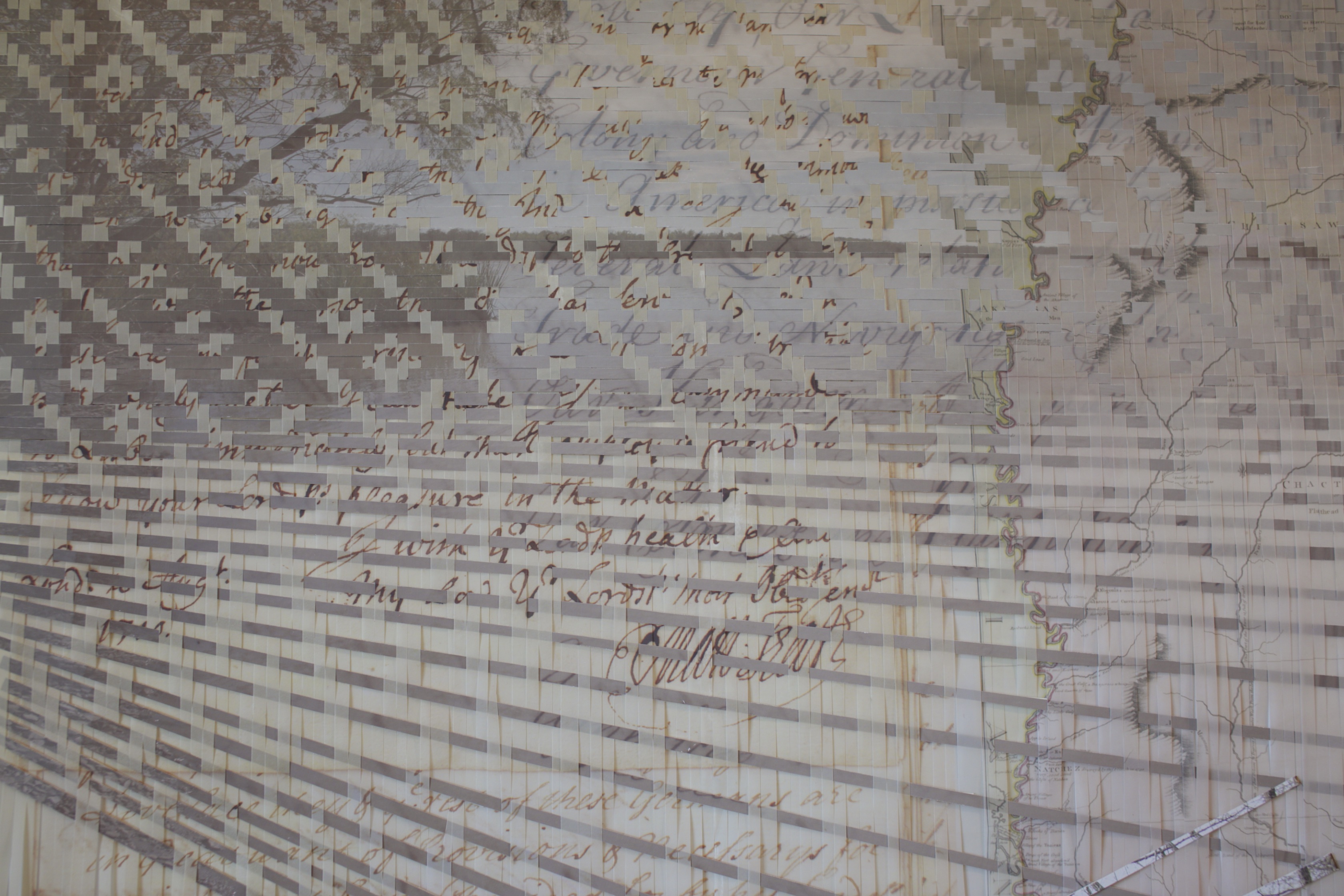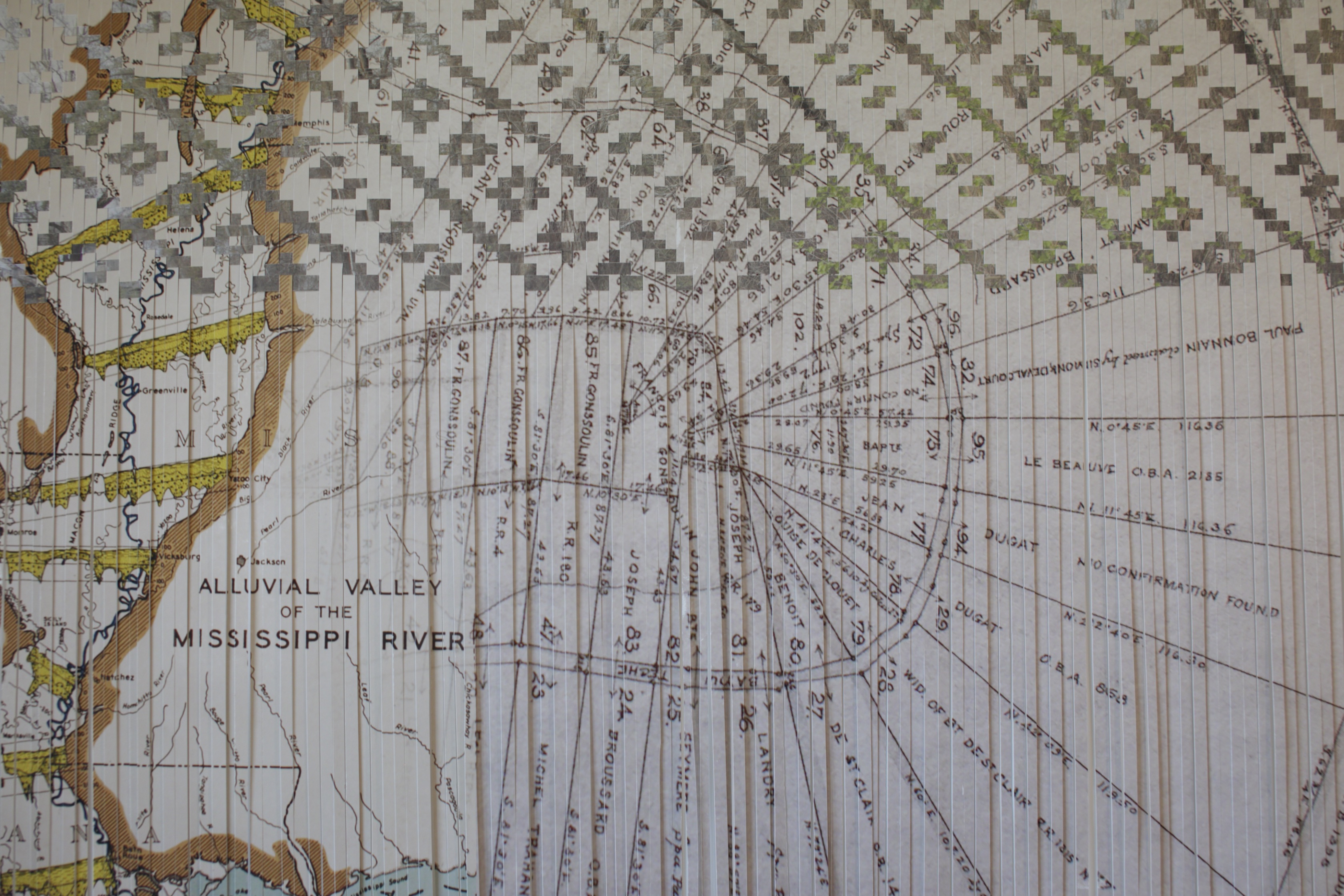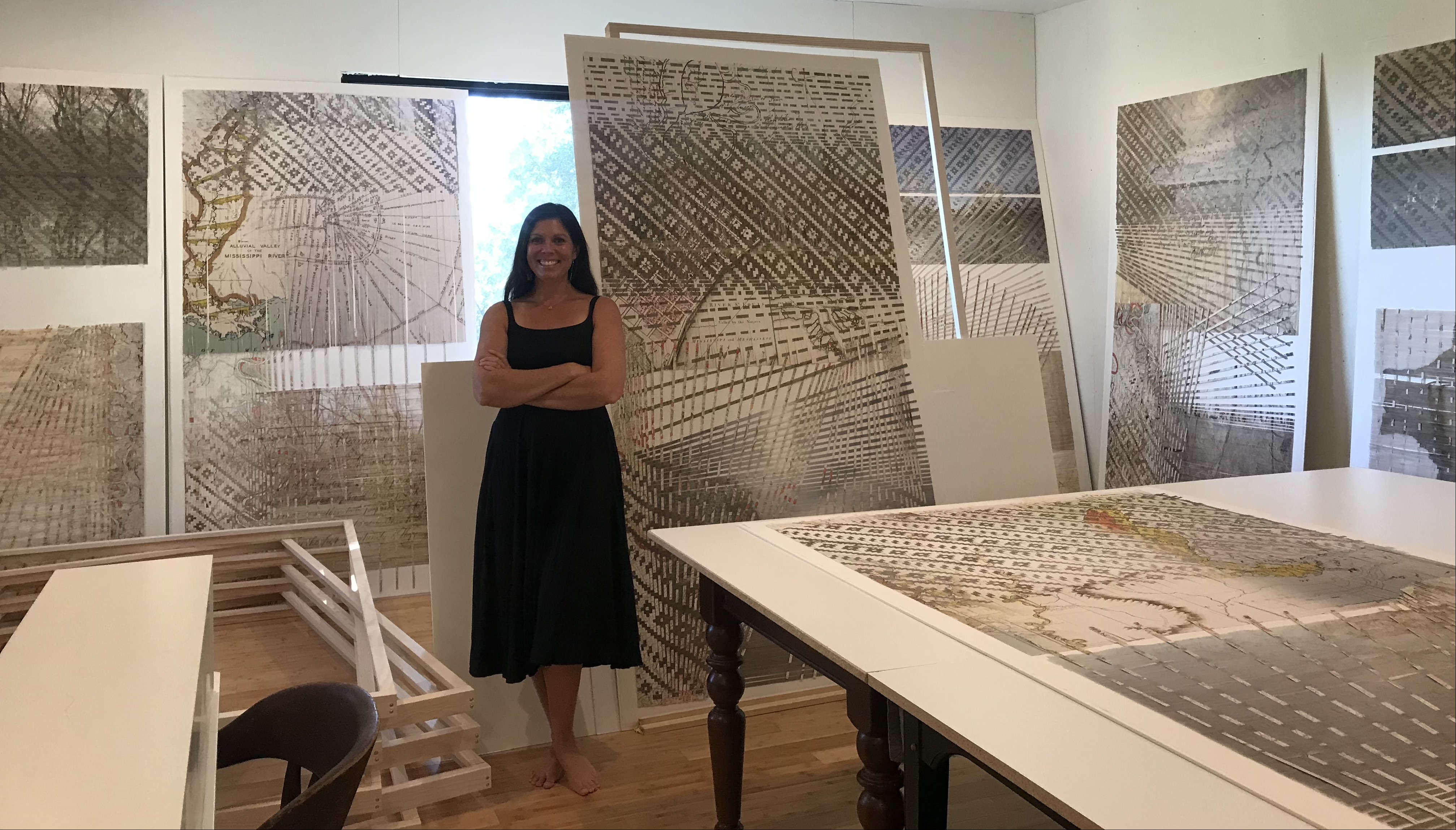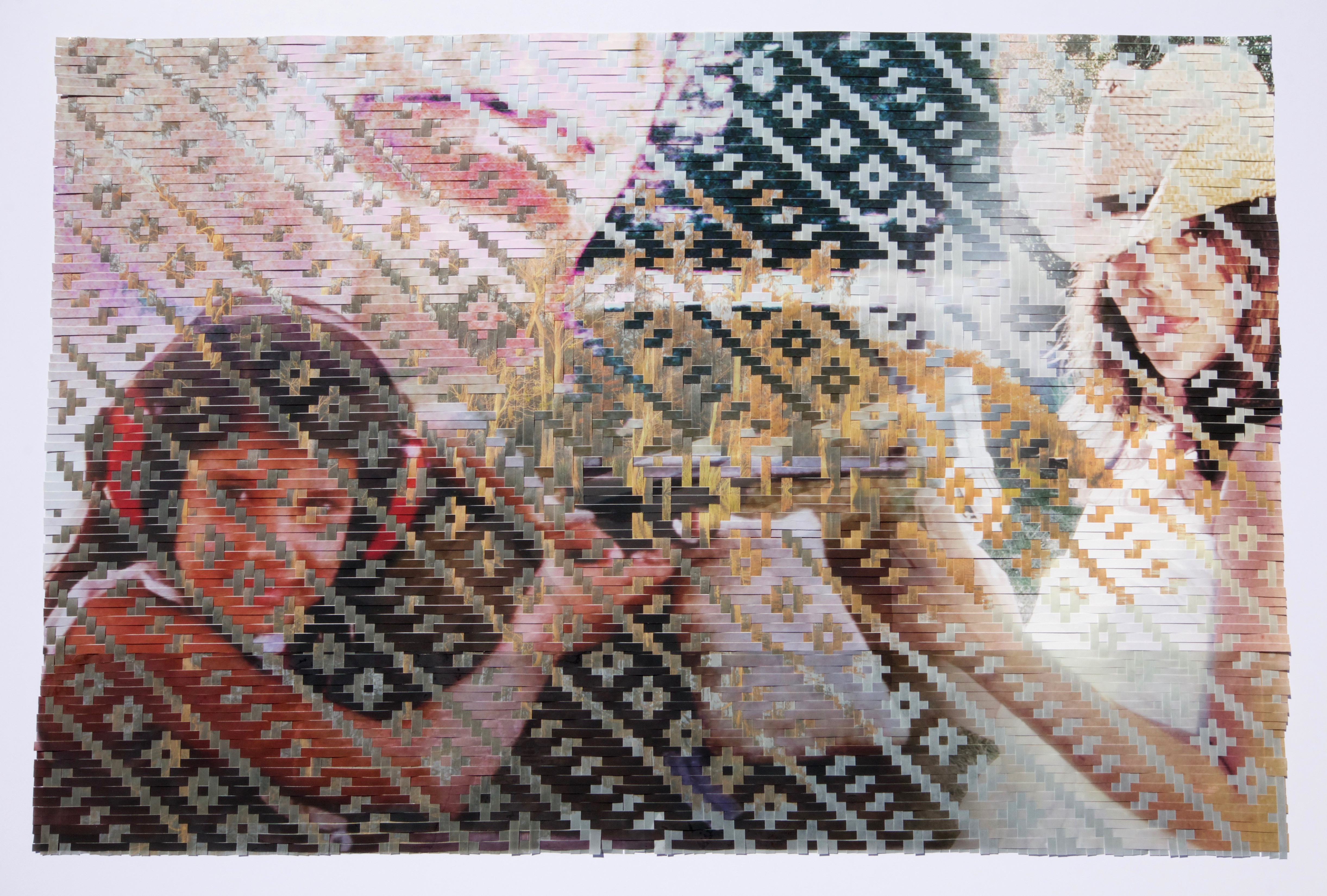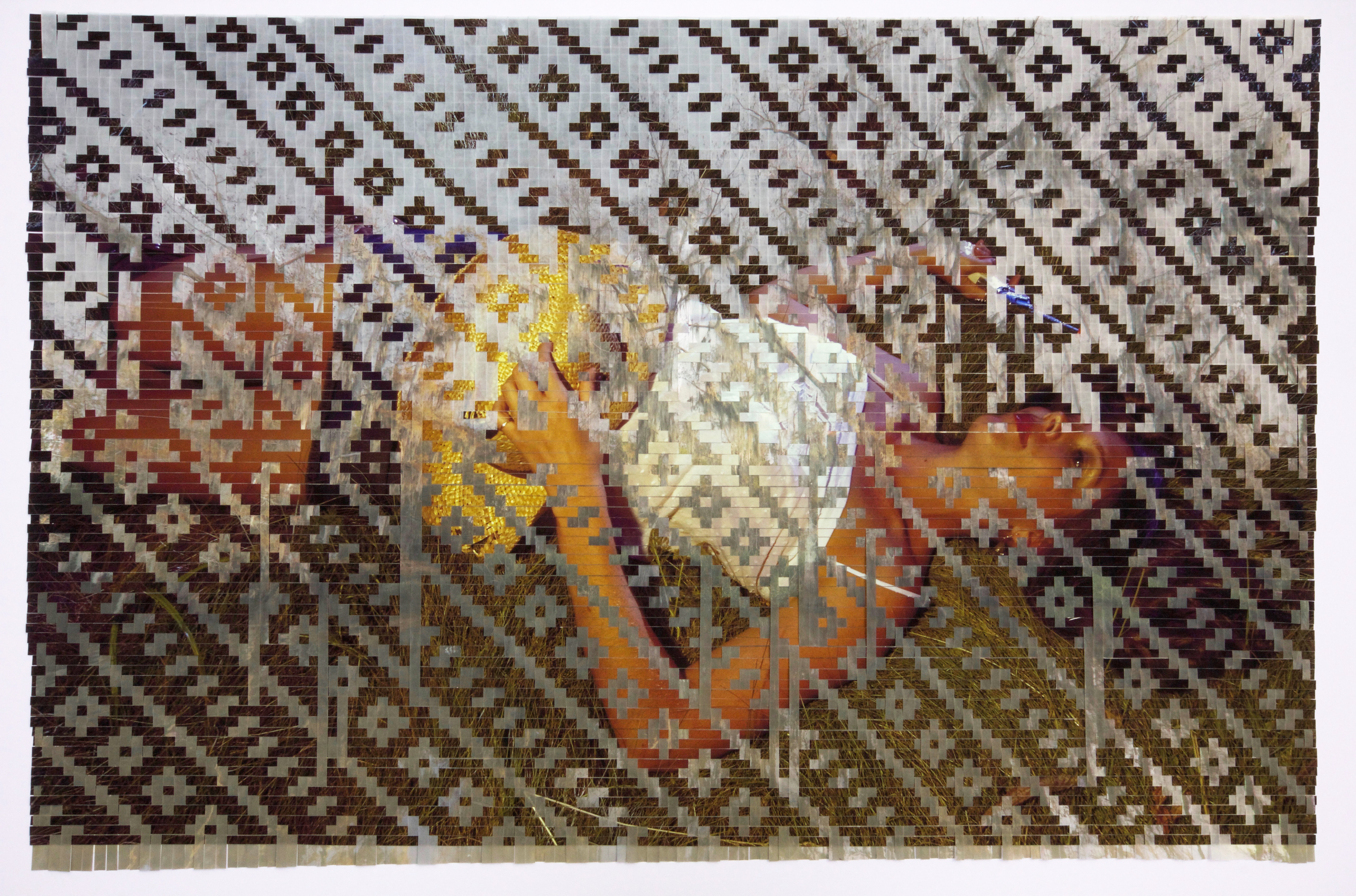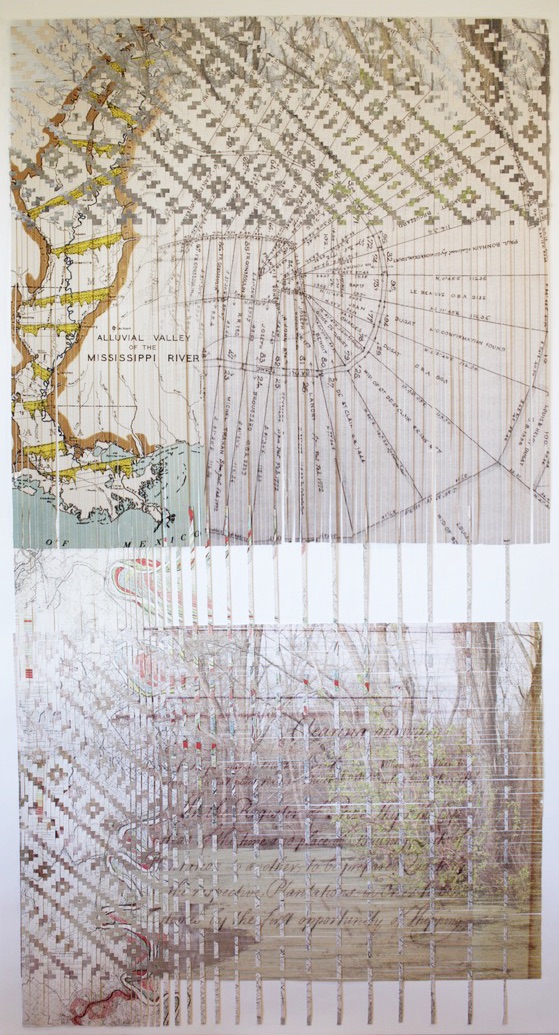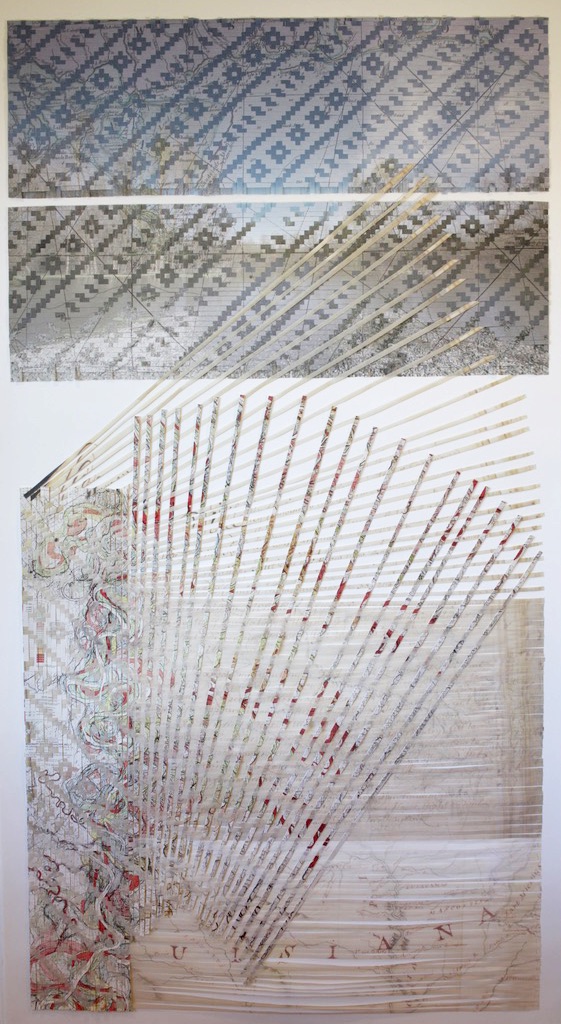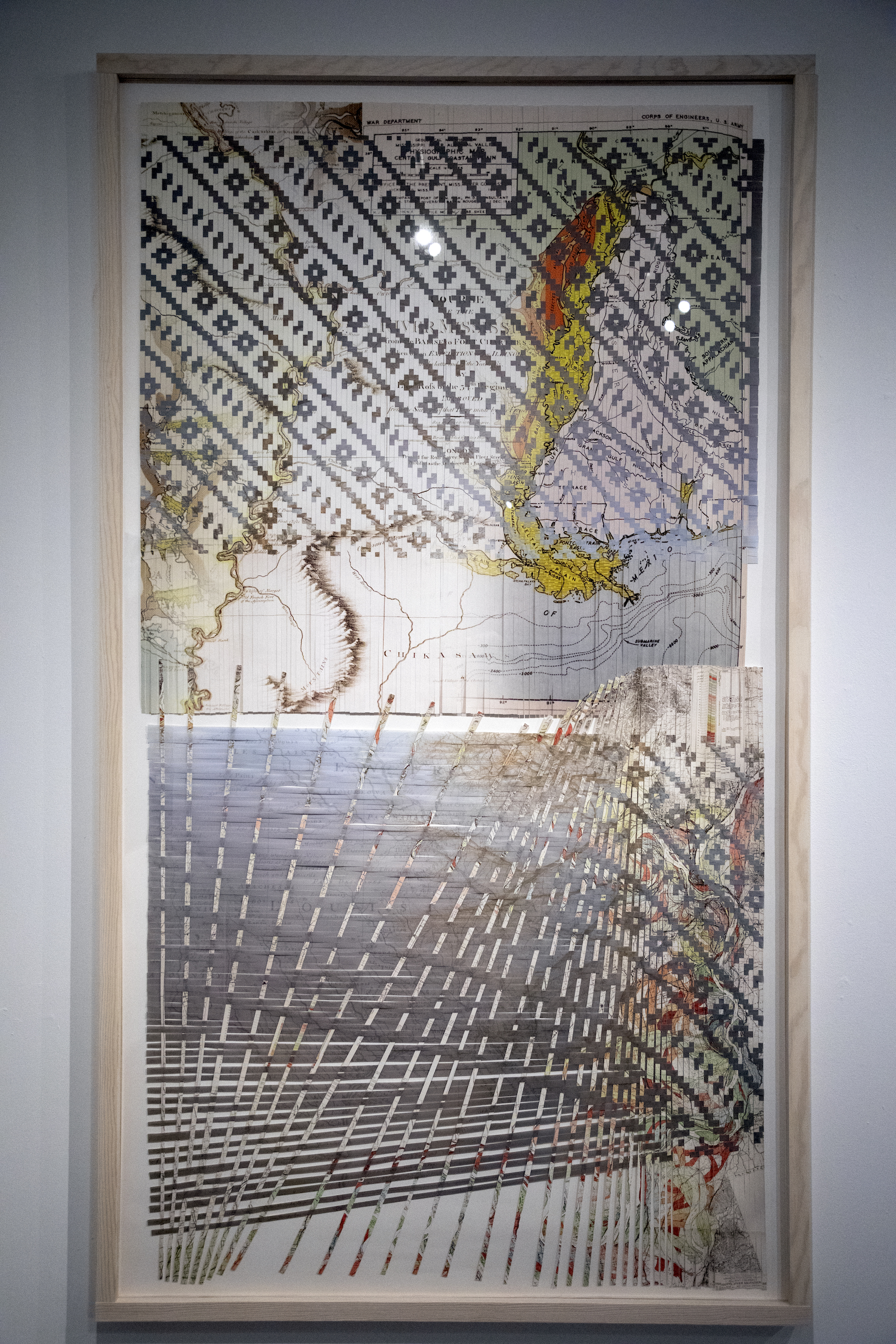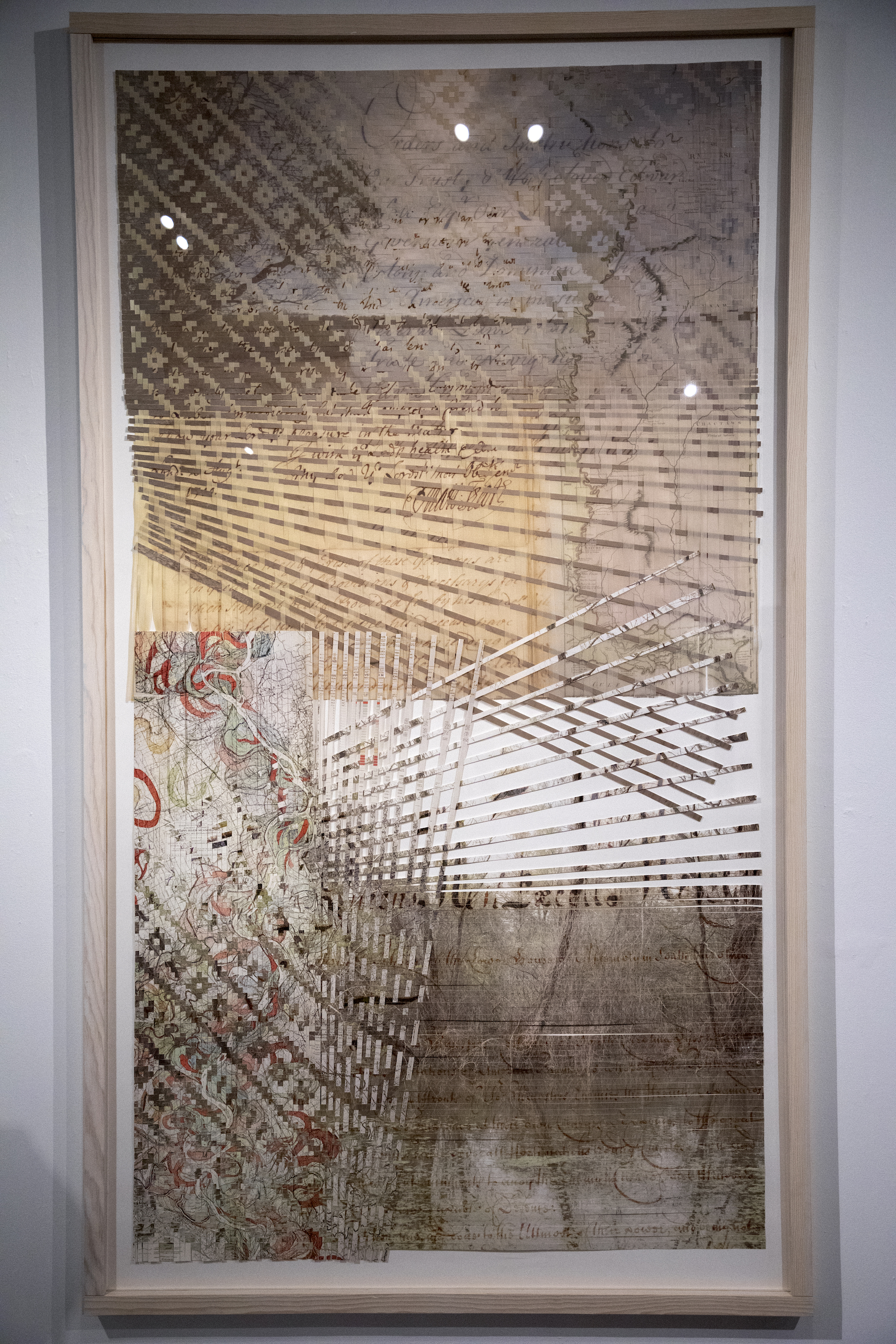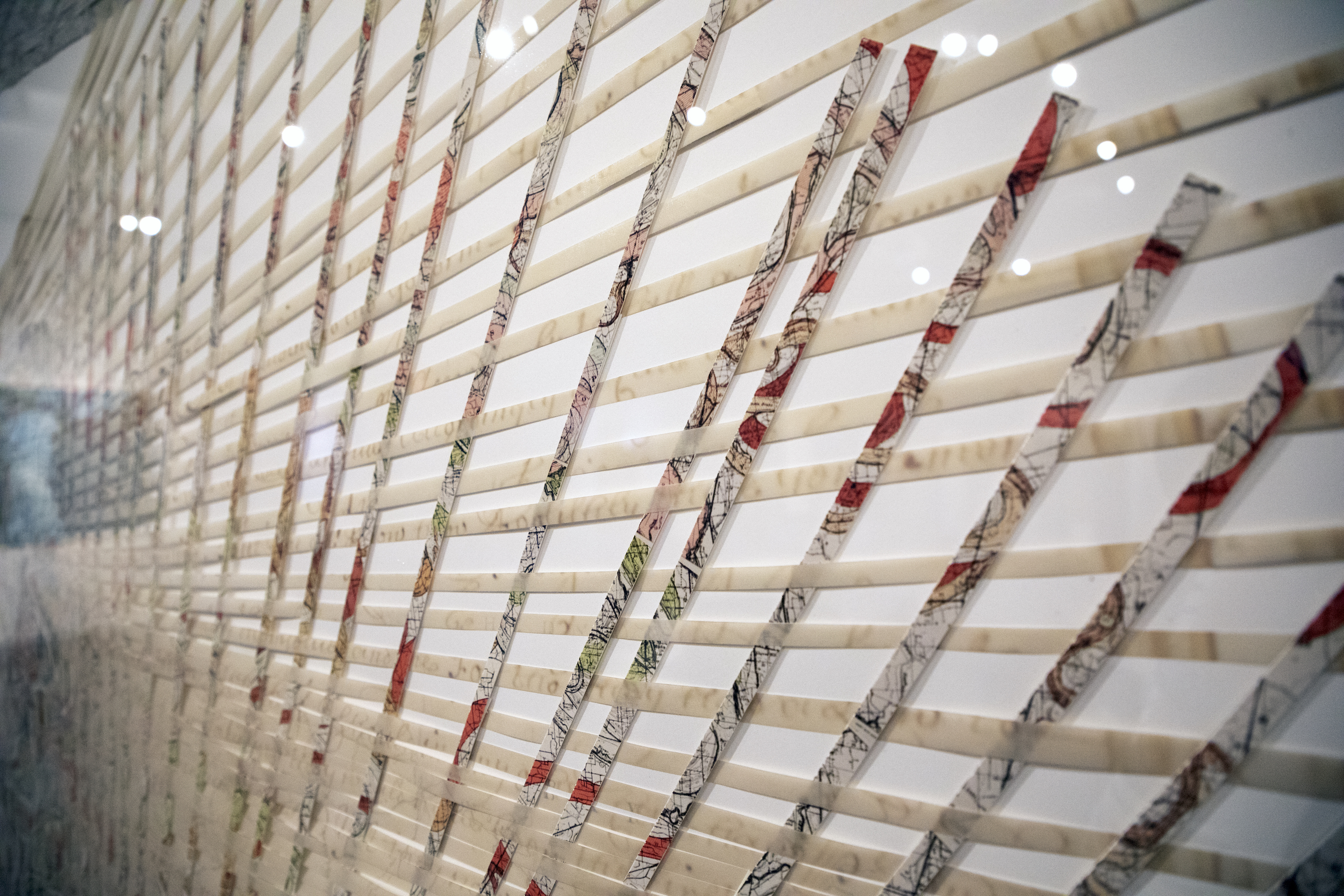I want to see the Chitimacha with more land. I want to see New Orleans recognize Chitimacha as the original people of New Orleans.
Sarah Sense
Sarah Sense is an artist from Sacramento, California (1980). She received a BFA from California State University Chico (2003), and a MFA from Parsons the New School for Design, New York (2005). Sense was the curator/director of the American Indian Community House Gallery (2005-07) where she catalogued the gallery’s thirty-year history. Sense has been practicing photo-weaving with traditional basket techniques from her Chitimacha and Choctaw family since 2004. Early works are based on Chitimacha landscape in Louisiana and Hollywood interpretations of Native North America. Sense moved to South America in 2010 for research, her work changed to include travels journals, landscape photography and family archives, telling stories to reveal Indigenous histories, most notably her field search of Native art from twelve countries in the Western Hemisphere, for the book and exhibition, Weaving the Americas in Valdivia and Santiago, Chile (2011). Sense traveled to Southeast Asia and the Caribbean for, Weaving Water debuting in Bristol, England (2013). While living in Ireland she collaborated with her Choctaw grandmother for Grandmother’s Stories at AHHA in Tulsa, Oklahoma (2015), followed by works about family lines and motherhood for Remember at the World Cultures Museum in Frankfurt, Germany (2016). Sense continues her research as a British Library Eccles Centre Visiting Fellow and recently installed a sculpture at the National Marine Aquarium in Plymouth, England. Her most recent commission for Florida State University is a large wall weaving of maps and documents from the British Library archive, Mississippi Meshassepi (2021), which will continue for a new commission including images from notable Texas archives for Amon Carter Museum, Fort Worth, Texas (2022). The new map and landscape weavings are focusing on colonial impacts on climate, with purpose to conceptually reinstate Indigeneity with traditional weaving patterns while decolonizing colonial maps.
In Fall 2019, Sarah joined our Humanities Without Walls project in Mississippi to talk about her weaving practice and Indigenous art and activism. She is in conversation with Caroline Wigginton here.
1. Tell us about weaving in Chitimacha and Choctaw communities. How did you come to learn and think about customary weaving? How would you characterize the relationship between weaving and the Mississippi River?
Weaving is a part of my identity. I have learned the practice by looking, drawing, watching, studying and dreaming. The first thing that I wove was made of three small photographic prints of a tanning salon on the Chitimacha reservation, with a sign reading, Native Tan (2004). I had been drawing and making small water colors with Chitimacha patterns for a few months before attempting the weaving, so I had already been studying the patterns and thinking about the practice. It was a fresh idea to bring the weaving, my photography and the patterns together into a single object that then became a thing. If I were to identify one moment that connected me to the practice, it would be impossible. It is a life of experiences, beginning with my mom and grandma. These women have a love for baskets and their culture, not matter how physically distant the space between self and aboriginal land may have grown. Their celebration of connectedness became individualized and that consistency impacted my own self. There is displacement and rupture in our family history that is a constant thought in my conceptual practice. I try to hold onto this feeling and convey such emotions into the weaving and image selection. My ways of being connected are individualized, just like my mom’s and my grandma’s; and while I didn’t know him very well, also my grandpa’s experiences. Often, I consider my relationship to my mom or to my grandma and then my relationship to my Native community and I conjure up a host of emotions tangled with fear, love, angst, disappointment, and overall bewilderment. It is a wonder that I am here with my lineage and my grandma’s legacy. Before she passed, she said, “Sarah, you are living the life that I wanted to live,” a compliment so complex with love, honor and commitment, that it may be the drive that keeps me weaving when I find myself in dark corners of history and family. It is with this purpose that I move through the stories and histories tied up in rage and loss. I weave to insert beauty in an otherwise disturbing history with the purpose of reasserting my family’s Indigenous weaving practice. My family’s rupture effects tradition continuing through the lineage, but in an effort to weave the gaps of time, I find peace and wish to convey those emotions of loss with hope and confidence. Much of these stories begin and continue in the Southeastern United States, where my Choctaw Grandma was raised in Oklahoma and my Chitimacha Grandpa was raised in Louisiana. My grandparents met each other in New Orleans and then had my mom in Maryland and eventually moved to California, which is where I was born. Visiting Oklahoma and more notably, Louisiana, has been impactful to my weaving practice and conceptual development of social and political issues. Including maps, landscapes, and photographs of the Mississippi River and Bayou Teche hold meaning for me about ancestral land and with that, memory. Recently, I have been researching in archives in London, Louisiana, and Texas where I have been photographing maps and images that I then print on paper, and cut into strips, so that I can then weave them together. The act of cutting and splicing the maps, is a way of decolonizing a drawing that was used as a tool to colonize. Weaving a traditional Chitimacha or Choctaw pattern through the maps is my way of conceptually re-indiginizing the land or the object. My most recent body of work is working with maps of the Mississippi River, Louisiana, and New Orleans; but these images and landscapes are broadening to include Texas for my next project.
2. You spent the last few months of the pandemic weaving new art for Florida State University Museum of Fine Arts’ A Shared Body exhibit while living near Lake Tahoe in Nisenan and Miwok territories now claimed by California. The weavings feature images and texts related to the Lower Mississippi River. What was the experience like and how has the memory of the Mississippi River shaped your creative output and your relationship to Indigenous lands and waters?
When you believe that water has memory, then meditating by a body of water will conjure up emotion, and for me, Bayou Teche and Atchafalaya makes me feel connected. New Orleans and the Mississippi River evoke other emotions and curiosities. I am interested in the many histories of New Orleans: French, Caribbean, Chitimacha, and their subsequent cultural impacts on music, food and Mardi Gras celebrations. Moreover, the colonial histories of New Orleans: Chitimacha enslavement by the French, African enslavement and displacement in the Southeast United States, mixing with Caribbean culture all while colonizers assimilated Native culture, people, language, stole land, and committed genocide. Likewise, the history of the Mississippi River and what I refer to as the colonizing of the Mississippi River and all of its neighboring communities. It can be overwhelming to digest the history, so I find amazement in the communities that still thrive and those who honor the culture and especially the basket weavers for continuing their traditions. I weave to tell these stories and to expose the truths that are hidden in the celebrations of American culture and to share the dark history with the beauty of weaving traditional patterns. The pandemic has opened up a reflective space to consider my place of privilege to make contemporary Native art and to be a part of the contemporary Native art community. I love this community and the opportunity to make new and different objects that are loaded with ideas and messages. I love seeing what my colleagues are making; it is an exciting time for Native artists. We are being invited to speak, to make and to be heard in places where previously Native people were not allowed to have a voice. This is my privilege. My time to make art is a privilege. Making this art and weaving is a choice. But I am aware that my choice to make this art is because of what others have done for me, and because there are traditional weavers in my community and there are cultural leaders in my community and political leaders in my community. I honor them and am grateful for all that they do.
3. When you joined our group in Mississippi, you shared your short film Vanity Photo Shoot Out. Why is it important to you to work outside of a single medium and what are some of the highlights as well as challenges of creating weavings from multiple media? What emerging or long-existing conversations/confluences between Indigenous art and activism in the context of the Mississippi have been most meaningful to you in think about the role and importance of older and newer media?
Documentary film can tell a story differently than a still piece of art. I made my first short video in 2003 just before I started weaving; it was a sort of gateway for me, and a way to include voices and music. Music evokes a host of emotions immediately and voices can trigger memory. The video helped me organize my ideas and draw themes to a surface. I am sure that this film would be really boring if I were to share it now, but sometimes, I go back to making short videos, which consistently have photographic elements, because it is another way to see a picture and another function of the camera. I can be more direct with a video, whereas a weaving is more curious and explorative for the weaver and the viewer. Both mediums of photography and video are important for my story telling, but the weaving is important for the preservation and understanding the strength of our culture, our people, and our history.
4. Your work seems deeply committed to thinking about specific places and moments in time. How have you researched these histories and backgrounds? How do different sources of knowledge—e.g. practitioners, family stories, academic scholarship, immersion in place—shape your perspective of what place is?
Traveling is a favorite part of my life. Meeting and talking to new people, exploring landscapes makes me feel alive and curious. I am always looking for connectedness, whether it is with a person or land or story. In my search to understand a place, I become very curious about the history. For example, when I lived in Chile, I enrolled in university and to take Spanish, human rights, and Indigenous history classes. When I spent a month in Germany, I researched my German grandpa’s family history in the archives of Krefield and Kiel, and then I went searching for family photo locations from the 1920s in the Black Forrest. When I lived in Ireland I spent Thanksgiving in the Famine Museum and then my research brought me to the Delphi Lodge where I ended up working, living and having my first son. Fondly, while living in Thailand I was making work for Weaving Water, and because of strange circumstances stayed on a small island and became a dive master, taking underwater photos that were a part of the Weaving Water series. Most notably, with Weaving the Americas, I interviewed Native artists on video while traveling through twelve counties. I just want to live exactly where I am and explore that space and time and then make something that is about that experience. Beyond that I have become very aware that I am not a scholar and want to lean more on historians and scholars for their expert knowledge.
5. How has climate change impacted your sense of Indigenous identity and how do you grapple with adaptation and the changing environment in your weavings?
Climate change has impacted my sense of humanness. I have gone to the extreme ends of reacting to climate change. In 2019, I searched for a plot of land near my family where I would be able to build an off grid eco home. This year we finished our house in Northern California and have off grid solar, two wells and septic. I have fourteen fruit trees and lots of land for growing more food and could have livestock. My reaction to Climate Change was to do three things: 1) make a safe home for my family where we would have control over our food, water and energy, while 2) making environmental choices that would be earth friendly, and 3) make art that would be educational about climate change and links to colonialism. These were our goals and I am grateful that we pursued this idea in 2019 prior to the pandemic real estate surge. Ideally, I would make more eco houses and communities. That seems to be impossible for now, so instead, I am making weavings about British colonial histories in Native North America and will continue to weave maps of the country, focusing on climate change, natural resources being colonized, and the negative implications on our environment.
6. How do your visual, video, and material inclinations complement and influence one another and inform your creative work? How can memory, art, and activism come together most productively in the space of the Lower Mississippi River Valley?
The short answer is weaving. The more interesting answer would be a documentary, though this is not on the table at the moment…yet. With my research at the British Library and recently at the Amon Carter Museum, Tulane University and University of Texas, Arlington, I can boldly say that maps are going to be an important part of my work for the next few years. At the moment, I am taken by the idea of maps as warfare and further, the colonial purposes of map making becoming a documented colonization of people and land, elevating destruction of natural resources and therefore causing climate change.
7. Let’s end on a speculative note: What kind of future would you like to envision for Native communities living in the Lower Mississippi River watershed?
I want to see the Chitimacha with more land. I want to see New Orleans recognize Chitimacha as the original people of New Orleans. I want the health care for Chitimacha to thrive. Sometimes when I am in New Orleans, I like to tell people that I am Chitimacha to see what they say, most don’t know that they are on Chitimacha ancestral land, and that is what I would like to see change. I am grateful for the land acknowledgements that are happening across the county, but I want to see it go beyond the institutions and into public spaces. Let’s honor each other and then we can do more healing.
